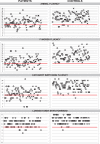The cerebellar cognitive affective/Schmahmann syndrome scale
- PMID: 29206893
- PMCID: PMC5837248
- DOI: 10.1093/brain/awx317
The cerebellar cognitive affective/Schmahmann syndrome scale
Abstract
Cerebellar cognitive affective syndrome (CCAS; Schmahmann's syndrome) is characterized by deficits in executive function, linguistic processing, spatial cognition, and affect regulation. Diagnosis currently relies on detailed neuropsychological testing. The aim of this study was to develop an office or bedside cognitive screen to help identify CCAS in cerebellar patients. Secondary objectives were to evaluate whether available brief tests of mental function detect cognitive impairment in cerebellar patients, whether cognitive performance is different in patients with isolated cerebellar lesions versus complex cerebrocerebellar pathology, and whether there are cognitive deficits that should raise red flags about extra-cerebellar pathology. Comprehensive standard neuropsychological tests, experimental measures and clinical rating scales were administered to 77 patients with cerebellar disease-36 isolated cerebellar degeneration or injury, and 41 complex cerebrocerebellar pathology-and to healthy matched controls. Tests that differentiated patients from controls were used to develop a screening instrument that includes the cardinal elements of CCAS. We validated this new scale in a new cohort of 39 cerebellar patients and 55 healthy controls. We confirm the defining features of CCAS using neuropsychological measures. Deficits in executive function were most pronounced for working memory, mental flexibility, and abstract reasoning. Language deficits included verb for noun generation and phonemic > semantic fluency. Visual spatial function was degraded in performance and interpretation of visual stimuli. Neuropsychiatric features included impairments in attentional control, emotional control, psychosis spectrum disorders and social skill set. From these results, we derived a 10-item scale providing total raw score, cut-offs for each test, and pass/fail criteria that determined 'possible' (one test failed), 'probable' (two tests failed), and 'definite' CCAS (three tests failed). When applied to the exploratory cohort, and administered to the validation cohort, the CCAS/Schmahmann scale identified sensitivity and selectivity, respectively as possible exploratory cohort: 85%/74%, validation cohort: 95%/78%; probable exploratory cohort: 58%/94%, validation cohort: 82%/93%; and definite exploratory cohort: 48%/100%, validation cohort: 46%/100%. In patients in the exploratory cohort, Mini-Mental State Examination and Montreal Cognitive Assessment scores were within normal range. Complex cerebrocerebellar disease patients were impaired on similarities in comparison to isolated cerebellar disease. Inability to recall words from multiple choice occurred only in patients with extra-cerebellar disease. The CCAS/Schmahmann syndrome scale is useful for expedited clinical assessment of CCAS in patients with cerebellar disorders.awx317media15678692096001.
Keywords: behaviour; cerebellar cognitive affective syndrome; cerebellum; cognition; rating scale.
© The Author (2017). Published by Oxford University Press on behalf of the Guarantors of Brain. All rights reserved. For Permissions, please email: journals.permissions@oup.com.
Figures






Comment in
-
Reply: Reference values for the Cerebellar Cognitive Affective Syndrome Scale: age and education matter.Brain. 2021 Mar 3;144(2):e21. doi: 10.1093/brain/awaa419. Brain. 2021. PMID: 33313688 No abstract available.
-
Reference values for the Cerebellar Cognitive Affective Syndrome Scale: age and education matter.Brain. 2021 Mar 3;144(2):e20. doi: 10.1093/brain/awaa417. Brain. 2021. PMID: 33367632 No abstract available.
References
-
- Adamaszek M, D'agata F, Ferrucci R, Habas C, Keulen S, Kirkby KC, et al.Consensus paper: cerebellum and emotion. Cerebellum 2017; 16: 552–76. - PubMed
-
- Arasanz CP, Staines WR, Roy EA, Schweizer TA. The cerebellum and its role in word generation: a cTBS study. Cortex 2012; 48: 718–24. - PubMed
-
- Benton AL, Hamsher K, Varney NR, Spreen O. Contributions to neuropsychological assessment. New York: Oxford University Press; 1983.
-
- Botez MI, Botez T, Elie R, Attig E. Role of the cerebellum in complex human behavior. Ital J Neurol Sci 1989; 10: 291–300. - PubMed
-
- Brandt J, Leroi I, O’Hearn E, Rosenblatt A, Margolis RL. Cognitive impairments in cerebellar degeneration: a comparison with Huntington’s disease. J Neuropsychiatry Clin Neurosci 2004; 16: 176–84. - PubMed
Publication types
MeSH terms
Grants and funding
LinkOut - more resources
Full Text Sources
Other Literature Sources
Medical

